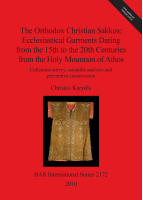Description
BOOK DESCRIPTION
This work focuses on the research findings from a collection survey of Euro-Mediterranean post-Byzantine ecclesiastical garments, known as sakkoi, from the Holy Mountain of Athos located in Chalkidiki, Greece. The sakkos appeared to be an evolution of the Greek chiton (10th - 8th BC) to the Roman dalmatic (180- 192 AD). The study begins with a discussion of the nomenclature, while it addresses the issue prevalent in Byzantine and post-Byzantine research, as to the historical provenance of this liturgicalgarment. Different approaches ranging from art historic and semiotic research to scientific examination using sophisticated analytical techniques are applied, in order to introduce a cultural, historical and technological context of the garments. The Mount Athos sakkoi, never previously researched, date from the end of the 15th to the 20th century and they are garments worn by Patriarchs, Bishops, and Emperors. The survey examines fifty two sakkoi from fourteen monasteries, identifying constructional andstylistic details, material components using analytical techniques (Optical Microscopy, HPLC and SEM-EDS) and technological evidence such as fibres, dyes, metal threads and weaving techniques, whilst analysing the sources of degradation and decay. This research demonstrates not only the scope of a conservation collection survey methodology for elucidating new information about specific items but also it's potential to add to the knowledge relating to the history, development and use of such garments. A major goal of the study was to enable intellectual access to this inaccessible collection and the mechanism for disseminating this information. Major attention was also drawn on new preventive conservation approaches that can be adopted to preserve the items as a 'living' collection, including guidelines for the continuation of production of those garments. The spiritual dimension of these artefacts is thus discussed within the framework of conservation ethics. This research offers for the very first time,a complete assemblage of knowledge regarding the production, synthesis, condition and display of the ecclesiastical Athonian sakkoi.











